More than a decade ago, a young entrepreneur with an interest in herbal supplements and a passion for health and performance began tinkering with formulas in the hope of creating something that could aid cognitive abilities. Aubrey Marcus consulted with scientists, ran experiments, put his nose to the grindstone, and, in 2010, Alpha BRAIN® was born—along with Onnit, the company Marcus co-founded to house the product. Today, Alpha BRAIN® is a leading brand in nootropic supplementation, having sold more than three million bottles.
As successful and effective as the original Alpha BRAIN® formula was and remains, we recognize that it doesn’t work for everyone, and we’ve gotten plenty of critiques and suggestions over the years on how to improve it. That led to different formulations and delivery systems, including instant drink mix powders and ready-to-drink liquids. We also wanted to reach different types of people, from professionals who want more focus for productivity to artists looking to stay in that creative zone and, most recently, athletes and gym rats seeking mental and physical support for greater exercise and sports performance. To that end, we’ve gradually expanded the Alpha BRAIN label to cover a family of products that all serve the same goal but work a little differently. Now, anyone who’s interested can find the version that’s right for them, and that aligns with their own individual taste and lifestyle.†
Consider the following your map to navigating all the current Alpha BRAIN® offerings, including the original game-changing formula, Alpha BRAIN® Instant, Focus Shot, Black Label, and the new Alpha BRAIN® Pre-Workout. But before you start exploring, let’s define what the Alpha BRAIN® family is for, and why you should consider it for your personal health and wellness journey.
What Is A Nootropic Supplement?

Nootropics are dietary supplements that support certain brain functions, including memory, mental speed, and focus. (Caffeine is a kind of nootropic.) All four Alpha BRAIN® formulas are nootropics, intended to promote alertness and quick thinking so that you can be more productive, but their ingredients, effects, and delivery mechanisms vary.†
There are two features common to most members of the Alpha BRAIN® (AB) family:
1) Ingredients that support neurotransmitters, the chemicals that relay information in and from the brain.†
2) Ingredients that promote focus and concentration.†
Most of the AB formulas contain huperzia serrata, a Clubmoss containing a compound called Huperzine A, which has been suggested to help slow the breakdown of acetylcholine (an important neurotransmitter).†1 Many of the ABs also have L-theanine, an amino acid found in teas that revs up alpha wave activity——electrical pulses that pass through the brain, shifting it into a calmer mode that contributes to quicker attentional processing and productivity.†2,3,4
In other words, by supporting the brain chemicals that allow you to concentrate and focus more deeply, the Alpha BRAIN formulas help keep your mind running on all cylinders.†
One of the key features of original Alpha BRAIN and AB Instant is their ability to help you get into flow state—that feeling of being in the zone.† You know those days when you’re so focused on what you’re doing that you don’t look up from your work for hours, and then suddenly realize it’s dark out? That’s called being in flow, and both AB and AB Instant have efficacious ingredients that can help you get into that headspace more often.†
What Is Alpha BRAIN®?

The original Alpha BRAIN® is Onnit’s flagship supplement and all time best-seller. It acts as a great introduction to the family, so to speak, serving as a general cognitive performance formula.† Alpha BRAIN® comes in capsule form and can be taken daily, or as needed.
Alpha BRAIN® Benefits
Alpha BRAIN® contains ingredients that can help you maintain mental focus and think more clearly.†
What Are Alpha BRAIN®’s Key Ingredients?
L-Theanine. An amino acid, L-theanine promotes alpha brain waves,† supports attention, and assists with reaction time.†8
Huperzia Serrata. A Clubmoss containing Huperzine A, a compound that helps slow the breakdown of acetylcholine in the body.†1,13
Alpha-GPC. A chemical compound found in the brain, it acts as a precursor to acetylcholine, aiding its production in the body.†11,12
Vitamin B6. B vitamins are known for their role in supporting energy, and this one specifically helps with nervous system function and neurotransmitter health.†5,6
Alpha BRAIN® is caffeine-free, dairy-free, gluten-free, and nut-free.
How Much Alpha BRAIN® Should I Take?
It’s best to start at one capsule (half a dose), assess your tolerance, and build up gradually from there. If you take one capsule and don’t feel anything after an hour or two, take another. If that feels good, the next time you use Alpha BRAIN®, take two capsules at once (one full dose, as recommended on the label). We do not recommend that you take more than one dose in 24 hours.
Many prefer to take Alpha BRAIN® in the morning with breakfast to support cognitive function at the start of the day, when they try to prioritize their most challenging tasks. But Alpha BRAIN® can be taken in the afternoon or evening, if you need your thinking to be on point at those times instead.†
Alpha BRAIN® is intended for adult use only.
Who Should Use Alpha BRAIN®?
If you’re new to the Alpha BRAIN® family, or nootropics in general, original Alpha BRAIN® is a good place to start. It will allow you to assess your tolerance and see if the ingredients that are common to the other AB products work for you. Alpha BRAIN® is good to use daily for general cognitive support, but it can be used only as needed, such as when working or studying.†
What Is Alpha BRAIN® Instant?
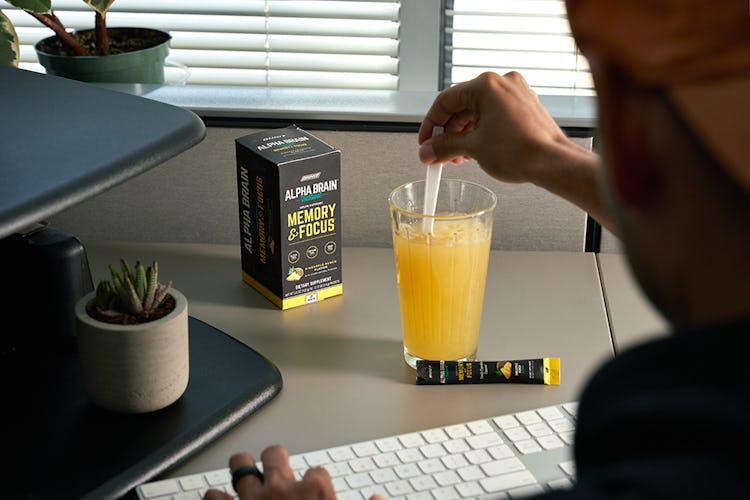
The Alpha BRAIN® Instant (ABI) formula is very similar to that of the original Alpha BRAIN®. It contains 500mg more of the amino acid tyrosine, and black pepper extract to aid absorption, but the main distinction is that ABI comes as an instant drink mix powder, for those who prefer to consume a supplement as a tasty drink rather than a capsule you have to swallow. The ABI packets may also be more convenient for some users to carry around (as opposed to a bottle), because they can fit easily into any pocket, purse, or bag.
You can mix ABI into water or any other liquid you choose with a spoon, or shake it up. It’s available in five different flavors—Ruby Grapefruit, Meyer Lemon, Pineapple Punch, Peach, and Blackberry Lemonade.
Alpha BRAIN® Instant is caffeine-free, dairy-free, and gluten-free.
How Much Alpha BRAIN® Instant Should I Take?
Start with one serving (1 packet) mixed with 8 ounces of cold water, preferably with a light meal. Do not take more than one packet in any 24-hour period.
Who Should Use Alpha BRAIN® Instant?
If you don’t like swallowing capsules, or you plan to use Alpha BRAIN® on the go (mixing it at a sink in your office, at a public water fountain, etc.), then Alpha BRAIN® Instant may be a more appropriate option than original Alpha BRAIN®. Of course, if you prefer to enjoy your supplements as a flavored drink that can accompany a meal, ABI is also the clear choice.
What Is Alpha BRAIN® Focus Shot?

AB Focus Shot is a liquid, ready-to-drink version of Alpha BRAIN®, similar to energy shots you’ve probably already seen. Its formula is slightly different from original AB and ABI, as it features new ingredients that support focus, energy, and mood.† Note that unlike the previous two AB incarnations, Focus Shot contains a small amount of caffeine (50mg, or about half of what’s in a typical cup of coffee). Because it fits in the palm of your hand and is easy to grab on the go and down in one shot, we like to say that AB Focus Shot is the most convenient way to get into deep focus.†
AB Focus Shot is available in two flavors—Peach and Tropical.
Alpha BRAIN® Focus Shot Benefits
As with its predecessors, Focus Shot aids cognitive performance, but it offers a few new ingredients that provide additional support for attention and focus, daily stress, and mood state.† This makes Focus Shot stand out from the pack of other energy shots. Focus Shot is designed to help you get into a state of alert relaxation, allowing you to think fast while staying cool under pressure, be it from work deadlines, car traffic, or other day-to-day stresses you experience.†
What Are Alpha BRAIN® Focus Shot’s Key Ingredients?
L-Tyrosine. This amino acid features in regular Alpha BRAIN® and ABI as well, but we pumped up the dose in Focus Shot to lend more support for cognitive performance.† One study, using large doses relative to bodyweight, shows that it helped military cadets keep their cool and problem-solve during a combat training course,14 while another indicates it may help with memory while multitasking.†15
Ashwagandha. An adaptogenic herb popular in traditional medicine, ashwagandha has shown very promising results for supporting the body’s stress response in similar amounts found in AB Focus Shot, as well as higher doses.†16
Cognizin® Citicoline. A naturally-occurring brain chemical, citicoline is essentially “brain food,” helping to maintain levels of neurotransmitters that support attention and focus.†18 When combined with caffeine, it can aid concentration, memory, and sustained attention even further.†19
Low-Dose, plant-based caffeine. In lower amounts, the stimulant found in coffee and tea promotes alertness and focus, but with subjects reporting a more relaxed mood and less nervousness and restlessness than when taking higher doses, especially when paired with L-theanine.†22
Alpha BRAIN® Focus Shot is dairy-free, gluten-free, and contains no artificial colors, flavors, or preservatives.
How Much Alpha BRAIN® Focus Shot Should I Take?
Focus Shot should be taken only once per day, or as needed. Do not exceed more than one bottle in a 24-hour period, and do not take it in addition to any other Alpha BRAIN® products or other nootropics.
Who Should Use Alpha BRAIN® Focus Shot?
Carrying a bottle of capsules may be too cumbersome, and packets of powder can be messy and difficult to mix on the go. Therefore, Alpha BRAIN® Focus Shot is the most convenient AB option. Focus Shot is also a good choice if you don’t mind consuming a low dose of caffeine, or you prefer that your energy supplements have it. It can be used daily, or as needed.†
What Is Alpha BRAIN® Black Label?
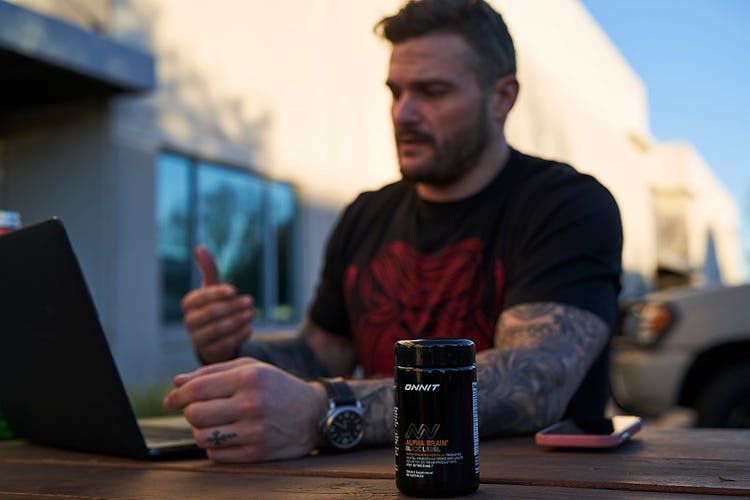
The premium member of the Alpha BRAIN® family, Alpha BRAIN® Black Label (ABBL) is a refined formula that goes one step further to promote mental processing speed and helps contribute to productivity. When taken daily, it can also support brain and eye health. Like AB Focus Shot, it contains a strategically low dose of caffeine (25mg) that can amp up cognitive benefits without the downside that higher doses of caffeine may cause. However, Black Label is only available in capsules.†
Alpha BRAIN® Black Label Benefits
We call ABBL our “break-glass-in-case-of-emergency, must-get-stuff-done now” formula because of its potential to support cognitive function and productivity like no other.† It has ingredients that promote deep focus, attention span, memory, relaxed alertness, and mood. Likewise, it can be taken daily to support eye health, which is beneficial for anyone who works in front of a computer or smartphone screen.†
What Are Alpha BRAIN® Black Label’s Key Ingredients?
Citicoline. As with AB Focus Shot, this brain chemical helps to maintain neurotransmitter levels, supporting attention and focus.†
Caffeine Anhydrous. A concentrated form of caffeine, supplied in a low dose here. The synergy of low-dose caffeine and L-theanine promotes alert relaxation, deep concentration, and a positive mood state.†
Lutemax 2020®. This extract from the marigold flower contains lutein and zeaxanthan, two plant carotenoids that have been found to support eye function on visual performance tests.†23,24 Lutein and zeaxanthan also help maintain general brain and eye health with continued use.†25,26,27 In fact, they’re particularly helpful for filtering out blue light—the kind emitted by electronic devices that contributes to eyestrain.† Research shows that lutein and zeaxanthan can absorb a significant amount of the blue light that enters the eyes.†28
Mucuna Pruriens. A tropical bean, it contains the amino acid L-Dopa, which is essential for healthy brain function.†
How Much Alpha BRAIN® Black Label Should I Take?
Refer to the directions for original Alpha BRAIN®, and work up to a full dose gradually. Ultimately, a full dose entails taking four capsules daily, or as needed, preferably with a light meal. Do not exceed four capsules in a 24-hour period, and do not take ABBL in addition to any other Alpha BRAIN® formula or other nootropic.
Who Should Use Alpha BRAIN® Black Label?
If you tried regular Alpha BRAIN® in the past and were disappointed, you may have a better experience with ABBL’s super-charged formula. Also, if you prefer a supplement that has a strategically small dose of caffeine, Black Label may be more appropriate.
ABBL is intended for use on days where you really feel under the gun, as it gives you the support you need for deep focus under important deadlines, hitting goals, etc., but it can also be used daily, if you choose, for general eye and brain health.† This makes ABBL an especially good choice for those who work in front of computer screens for long periods, or who drive long distances, and need support in remaining attentive and reactive behind the wheel.†
What Is Alpha BRAIN® Pre-Workout?
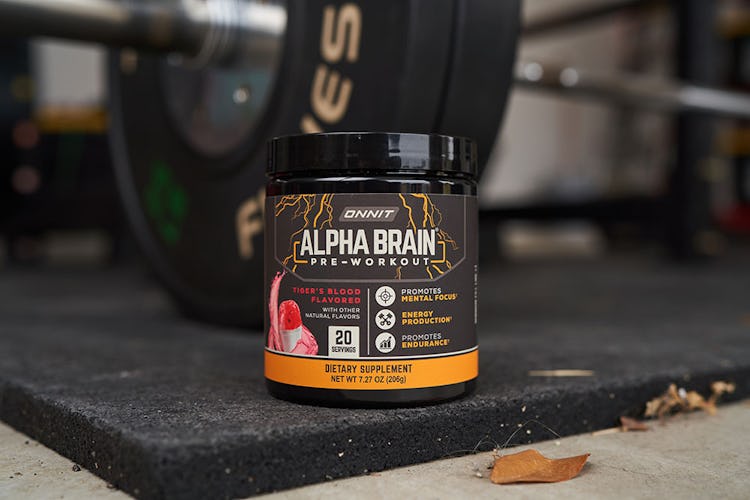
Alpha BRAIN Pre-Workout is the newest addition to the AB Family. Combining cognitive support benefits with compounds that promote endurance and power, it’s the ideal Alpha BRAIN formula to consume before exercise.
Alpha BRAIN Pre-Workout Benefits
AB Pre-Workout helps charge up both the mind and body, supporting focus and mental sharpness, muscle endurance and power, and energy production specifically for exercise. It can also help to reduce levels of perceived exertion.†
What Are Alpha BRAIN Pre-Workout’s Key Ingredients?
Caffeine anhydrous. Caffeine is well known for promoting alertness and aiding mental processing speed and sharpness29. The dosage of concentrated caffeine extract used here (200mg, which is approximately the same amount you’d get from two cups of coffee) has also been shown to support movement speed30, muscle power31, 32 and endurance33, in part by reducing the perception of effort.†
Furthermore, one trial has shown that caffeine can help with physical skill performance when deprived of rest34.
Beta Alanine. An amino acid like creatine monohydrate, beta alanine is also similar to the world’s most popular sports supplement for its potential to aid exercise performance. Evidence published in two journals backs beta alaline’s use for promoting exercise capacity.† 35, 36
Noogandha®. A 2022 trial found that this trademarked form of ashwagandha extract supports mental agility, concentration, and mental processing speed while helping to manage the physiological, cognitive, and psychological effects of normal stress.†37
L-Citrulline. An amino acid that was first found in watermelon, citrulline promotes endurance performance and helps with exercise-induced muscle fatigue.†38
AlphaSize®. Remember Alpha-GPC? This special form supplies choline, a nutrient that is important to the nervous system and necessary for healthy brain functioning.†
Dynamine™. A trademarked version of methylliberine, a methylxanthine metabolite, Dynamine™ is gaining popularity in the sports nutrition space for its ability to complement caffeine.
How Much Alpha BRAIN Pre-Workout Should I Take?
Take one serving (one scoop) mixed with 10–14 ounces water 20–30 minutes prior to training. Do not exceed one serving in a 24-hour period. To avoid side effects of too much caffeine, don’t combine Pre-Workout with other foods or supplements that contain more than 50mg of caffeine.
Who Should Use Alpha BRAIN Pre-Workout?
AB Pre-Workout is a good option for anyone who wants to feel more alert and energized for exercise sessions, whether they’re endurance or strength-focused. Athletes can benefit from it, as well as gym rats who have to train early in the morning (and are usually otherwise groggy as a result).†
REFERENCES:
1. Skidmore-Roth, Linda. Mosby’s handbook of herbs & natural supplements. Elsevier Health Sciences, 2009.
2. Nobre, Anna C., Anling Rao, and Gail N. Owen. “L-theanine, a natural constituent in tea, and its effect on mental state.” Asia Pacific journal of clinical nutrition 17 (2008).
3. Nathan, Pradeep J., Kristy Lu, Marcus Gray, and C. Oliver. “The neuropharmacology of L-theanine (N-ethyl-L-glutamine) a possible neuroprotective and cognitive enhancing agent.” Journal of Herbal Pharmacotherapy 6, no. 2 (2006): 21-30.
4. SONG, Chan-Hee, Ju-Hae JUNG, Je-Sung OH, and Kyung-Soo KIM. “Effects of theanine on the release of brain alpha wave in adult males.” The Korean Journal of Nutrition (2003): 918-923.
5. Yarlagadda, Atmaram, and Anita H. Clayton. “Blood brain barrier: the role of pyridoxine.” Psychiatry (Edgmont) 4, no. 8 (2007): 58.
6. Lippincott-Raven. (1999). Chapter 12. Catecholamines, Chapter 13. Serotonin. In Basic neurochemistry: Molecular, cellular and medical aspects.
7. Banderet, Louis E., and Harris R. Lieberman. “Treatment with tyrosine, a neurotransmitter precursor, reduces environmental stress in humans.” Brain research bulletin 22, no. 4 (1989): 759-762.
8. Higashiyama, Akiko, Hla Hla Htay, Makoto Ozeki, Lekh R. Juneja, and Mahendra P. Kapoor. “Effects of l-theanine on attention and reaction time response.” Journal of Functional Foods 3, no. 3 (2011): 171-178.
9. Leventis, Peter A., and Sergio Grinstein. “The distribution and function of phosphatidylserine in cellular membranes.” Annual review of biophysics 39, no. 1 (2010): 407-427.
10. Kim, Hee-Yong, Bill X. Huang, and Arthur A. Spector. “Phosphatidylserine in the brain: metabolism and function.” Progress in lipid research 56 (2014): 1-18.
11. Tayebati, Seyed Khosrow, and Francesco Amenta. “Choline-containing phospholipids: relevance to brain functional pathways.” Clinical Chemistry and Laboratory Medicine 51, no. 3 (2013): 513-521.
12. Brownawell, Amy M., Edward L. Carmines, and Federica Montesano. “Safety assessment of AGPC as a food ingredient.” Food and chemical toxicology 49, no. 6 (2011): 1303-1315.
13. Tun, Maung Kyaw Moe, and Seth B. Herzon. “The pharmacology and therapeutic potential of (—)-huperzine A.” Journal of Experimental Pharmacology 4 (2012): 113.
14. Deijen, J. B., C. J. E. Wientjes, H. F. M. Vullinghs, P. A. Cloin, and J. J. Langefeld. Brain research bulletin 48, no. 2 (1999): 203-209.
15. Thomas, John R., Park A. Lockwood, Anita Singh, and Patricia A. Deuster. “Tyrosine improves working memory in a multitasking environment.” Pharmacology Biochemistry and Behavior 64, no. 3 (1999): 495-500.
16. Salve, Jaysing, Sucheta Pate, Khokan Debnath, and Deepak Langade. “Adaptogenic and anxiolytic effects of ashwagandha root extract in healthy adults: a double-blind, randomized, placebo-controlled clinical study.” Cureus 11, no. 12 (2019).
17. Choudhary, Dnyanraj, Sauvik Bhattacharyya, and Sekhar Bose. “Efficacy and safety of Ashwagandha (Withania somnifera (L.) Dunal) root extract in improving memory and cognitive functions.” Journal of Dietary Supplements 14, no. 6 (2017): 599-612.
18. Erin, McGlade, Locatelli Allison, Hardy Julia, Kamiya Toshikazu, Morita Masahiko, Morishita Koji, Sugimura Yoichiro, and Yurgelun-Todd Deborah. “Improved attentional performance following citicoline administration in healthy adult women.” Food and Nutrition Sciences 2012 (2012).
19. Bruce, Steven E., Kimberly B. Werner, Brittany F. Preston, and Laurie M. Baker. “Improvements in concentration, working memory and sustained attention following consumption of a natural citicoline–caffeine beverage.” International journal of food sciences and nutrition 65, no. 8 (2014): 1003-1007.
20. Saitsu, Yuusuke, Akemi Nishide, Kenji Kikushima, Kuniyoshi Shimizu, and Koichiro Ohnuki. “Improvement of cognitive functions by oral intake of Hericium erinaceus.” Biomedical Research 40, no. 4 (2019): 125-131.
21. Vigna, Luisella, Federica Morelli, Gianna M. Agnelli, Filomena Napolitano, Daniela Ratto, Alessandra Occhinegro, Carmine Di Iorio et al. Evidence-Based Complementary and Alternative Medicine 2019 (2019).
22. Kaplan, Gary B., David J. Greenblatt, Bruce L. Ehrenberg, Jill E. Goddard, Monette M. Cotreau, Jerold S. Harmatz, and Richard I. Shader. “Dosedependent pharmacokinetics and psychomotor effects of caffeine in humans.” The Journal of Clinical Pharmacology 37, no. 8 (1997): 693-703.
23. Stringham, James M., Nicole T. Stringham, and Kevin J. O’Brien. “Macular carotenoid supplementation improves visual performance, sleep quality, and adverse physical symptoms in those with high screen time exposure.” Foods 6, no. 7 (2017): 47.
24. Ceravolo, S. Anna, Billy R. Hammond, William Oliver, Brett Clementz, L. Stephen Miller, and Lisa M. RenziHammond. “Dietary Carotenoids Lutein and Zeaxanthin Change Brain Activation in Older Adult Participants: A Randomized, DoubleMasked, PlaceboControlled Trial.” Molecular nutrition & food research 63, no. 15 (2019): 1801051.
25. Koushan, Keyvan, Raluca Rusovici, Wenhua Li, Lee R. Ferguson, and Kakarla V. Chalam. “The role of lutein in eye-related disease.” Nutrients 5, no. 5 (2013): 1823-1839.
26. Wilson, Lisa M., Saraniya Tharmarajah, Yuanxi Jia, Richard D. Semba, Debra A. Schaumberg, and Karen A. Robinson. “The effect of lutein/zeaxanthin intake on human macular pigment optical density: A systematic review and meta-analysis.” Advances in Nutrition 12, no. 6 (2021): 2244-2254.
27. Yagi, Ayano, Rui Nouchi, Laurie Butler, and Ryuta Kawashima. “Lutein has a positive impact on brain health in healthy older adults: a systematic review of randomized controlled trials and cohort studies.” Nutrients 13, no. 6 (2021): 1746.
28. Krinsky, Norman I., John T. Landrum, and Richard A. Bone. “Biologic mechanisms of the protective role of lutein and zeaxanthin in the eye.” Annual review of nutrition 23, no. 1 (2003): 171-201.
29. Health Canada. www.hc-sc.gc.ca
30. European Food Safety Authority. www.efsa.europa.eu/en/topics/topic/caffeine
31. Diaz-Lara, Francisco Javier, Juan Del Coso, Jose Manuel GarcÃa, Luis J. Portillo, Francisco Areces, and Javier Abián-Vicén. “Caffeine improves muscular performance in elite Brazilian Jiu-jitsu athletes.” European Journal of Sport Science 16, no. 8 (2016): 1079-1086.
32. Grgic, Jozo, Eric T. Trexler, Bruno Lazinica, and Zeljko Pedisic. “Effects of caffeine intake on muscle strength and power: a systematic review and meta-analysis.” Journal of the International Society of Sports Nutrition 15, no. 1 (2018): 11.
33. Government of Canada. www.canada.ca/en/health-canada/services/food-nutrition/food-safety/food-additives/caffeine-foods.html
34. Cook, Christian J., Blair T. Crewther, Liam P. Kilduff, Scott Drawer, and Chris M. Gaviglio. “Skill execution and sleep deprivation: effects of acute caffeine or creatine supplementation-a randomized placebo-controlled trial.” Journal of the international society of sports nutrition 8, no. 1 (2011): 2.
35. Van Thienen, Ruud, Karen Van Proeyen, J. Puype, T. Lefere, and P. Hespel. “Beta-alanine improves sprint performance in endurance cycling.” Medicine and science in sports and exercise 41, no. 4 (2009): 898-903.
36. Saunders, Bryan, Kirsty Elliott-Sale, Guilherme G. Artioli, Paul A. Swinton, Eimear Dolan, Hamilton Roschel, Craig Sale, and Bruno Gualano. “β-alanine supplementation to improve exercise capacity and performance: a systematic review and meta-analysis.” British journal of sports medicine 51, no. 8 (2017): 658-669.
37. Remenapp, A., K. Coyle, T. Orange, T. Lynch, D. Hooper, S. Hooper, K. Conway, and H. A. Hausenblas. “Efficacy of Withania somnifera supplementation on adult’s cognition and mood.” Journal of Ayurveda and Integrative Medicine 13, no. 2 (2022): 100510.
38. Suzuki, Takashi, Masahiko Morita, Yoshinori Kobayashi, and Ayako Kamimura. “Oral L-citrulline supplementation enhances cycling time trial performance in healthy trained men: Double-blind randomized placebo-controlled 2-way crossover study.” Journal of the International Society of Sports Nutrition 13, no. 1 (2016): 6.
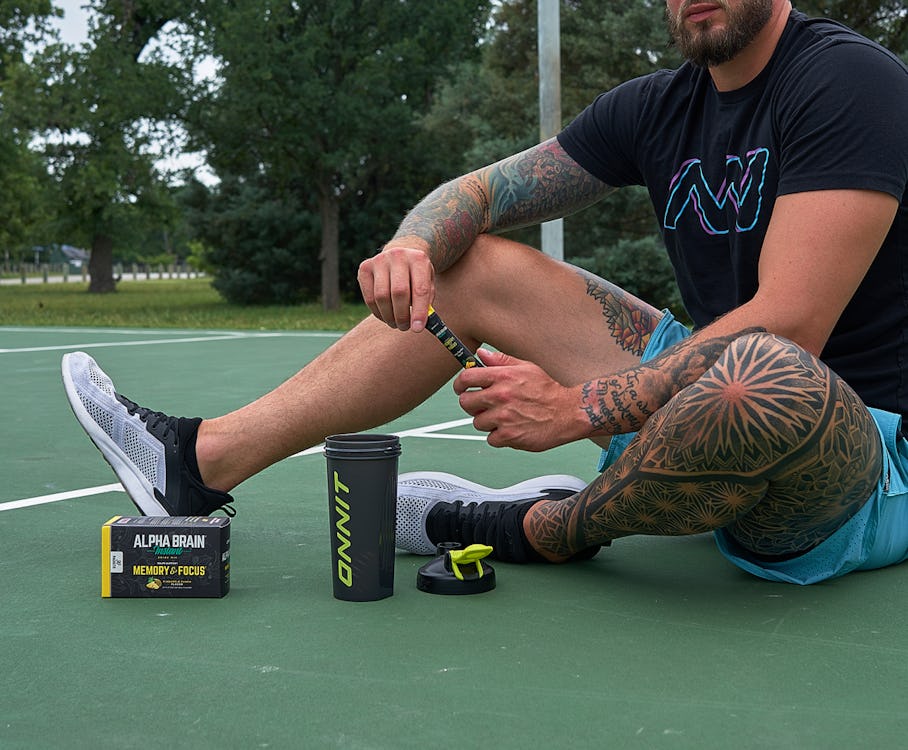
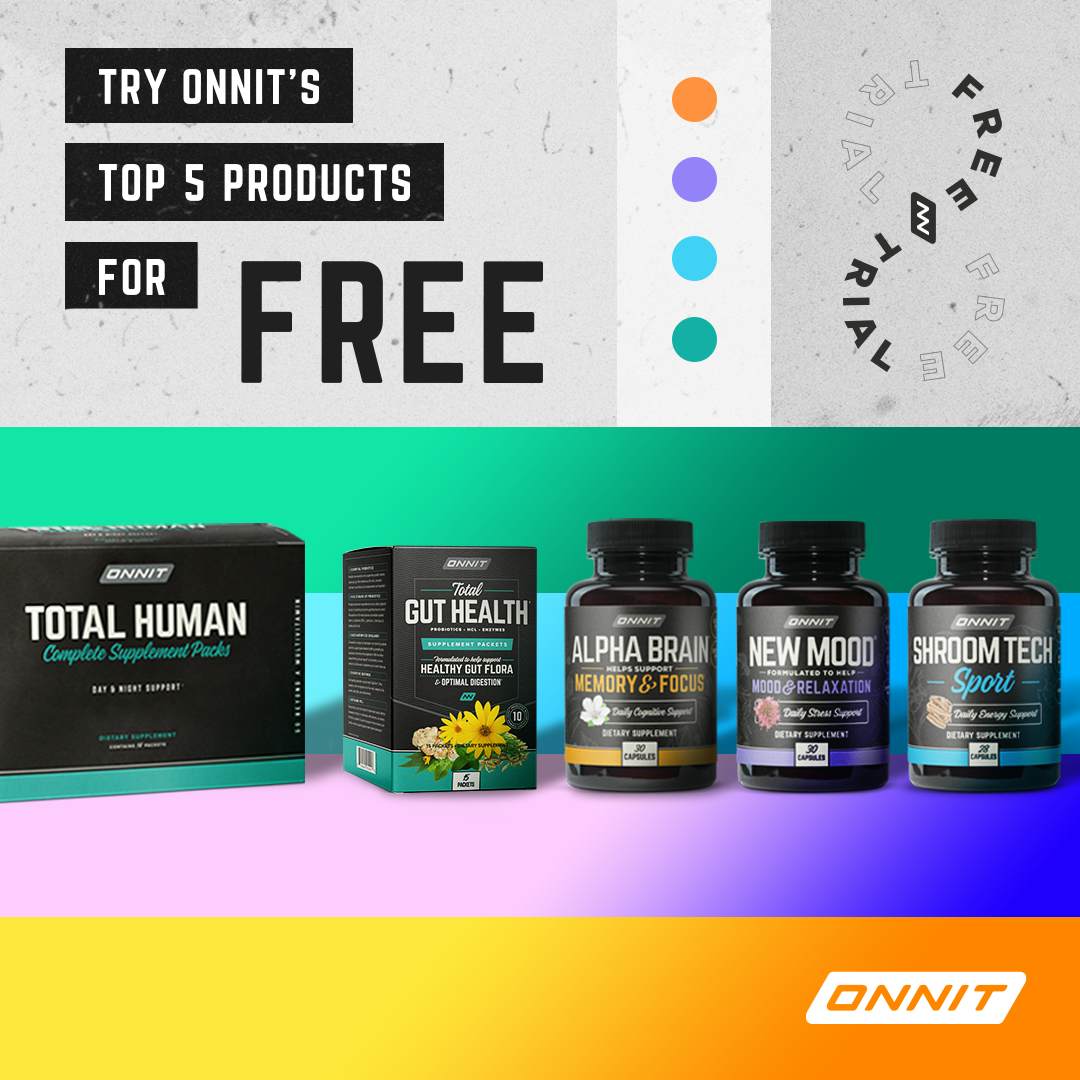)





